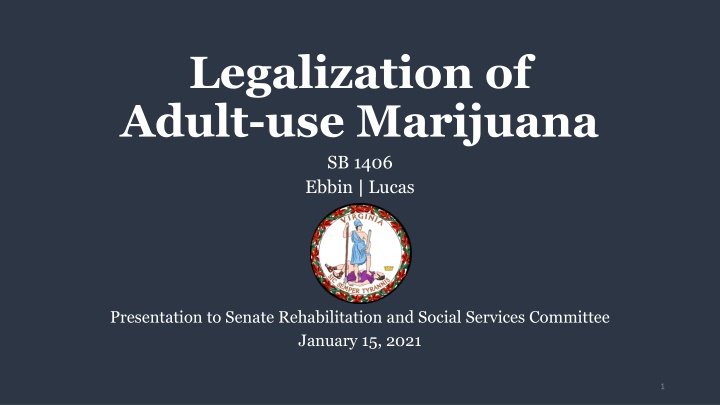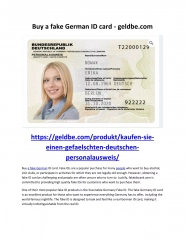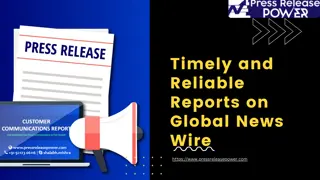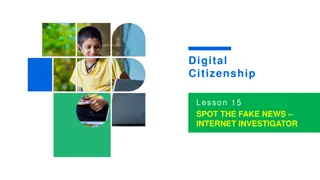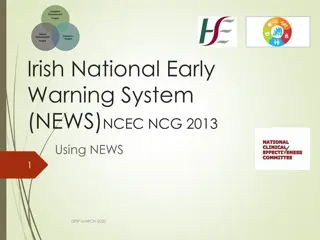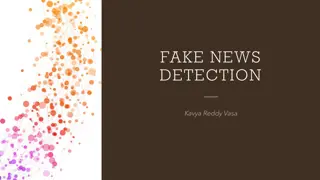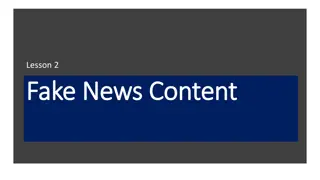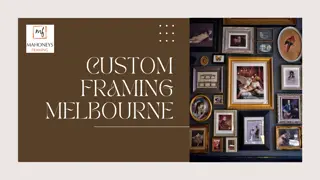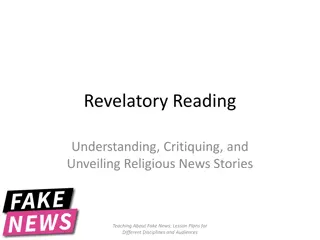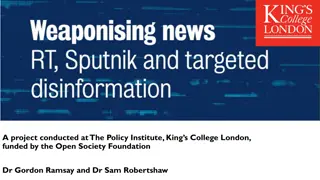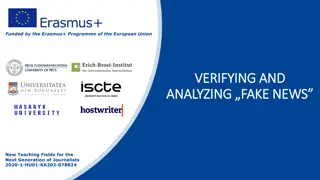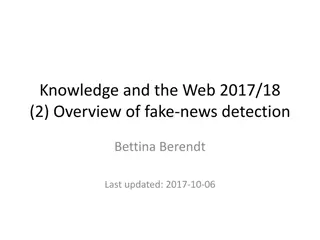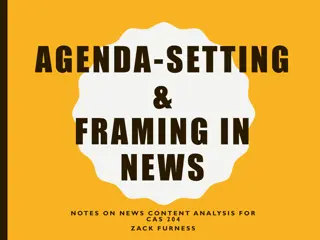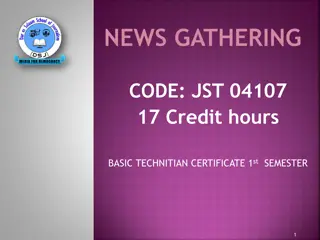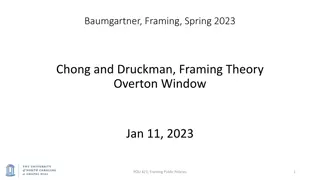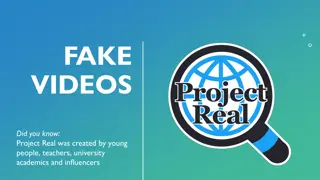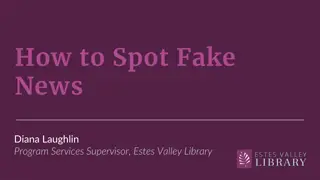Battling Fake Science News: The Power of Framing
Framing in science communication is crucial to combatting fake news. Learn about the influence of framing, detecting fake science news, and ethical considerations in framing. Discover insights from experts and teaching strategies to address misinformation effectively.
Download Presentation

Please find below an Image/Link to download the presentation.
The content on the website is provided AS IS for your information and personal use only. It may not be sold, licensed, or shared on other websites without obtaining consent from the author.If you encounter any issues during the download, it is possible that the publisher has removed the file from their server.
You are allowed to download the files provided on this website for personal or commercial use, subject to the condition that they are used lawfully. All files are the property of their respective owners.
The content on the website is provided AS IS for your information and personal use only. It may not be sold, licensed, or shared on other websites without obtaining consent from the author.
E N D
Presentation Transcript
Legalization of Adult-use Marijuana SB 1406 Ebbin | Lucas Presentation to Senate Rehabilitation and Social Services Committee January 15, 2021 1
Virginias Marijuana Path 2015 First law to allow possession of some cannabis oils by patients with specific medical needs 2016 Creation of pharmaceutical processor program 2017 Re-enactment of pharmaceutical processor program and finalization of regulations 2018 Expansion of diagnosed conditions 2019 Additional expanded authority for health professionals and processors 2020 Allowance for up to 5 additional dispensing facilities Also 2020 Decriminalization of simple marijuana possession 2
Two Separate Marijuana Studies Joint Audit and Legislative Review Commission (JLARC) report conducted throughout 2020 Spoke to other states who have legalized marijuana Talked to stakeholders and state regulators Focused on public health and social equity as well Final report released in November Marijuana Legalization Work Group mandated by 2020 s marijuana decriminalization bill 21 members: policy experts, health professionals, government officials, and community leaders Talked to other states, criminal justice reform advocates, and other marijuana and social equity policy thought leaders 15 public meetings between July and October Final report released in November 3
Governor Northams Priorities Social equity, racial equity, and economic equity Public health Protections for young people Upholding the Virginia Indoor Clean Air Act Data collection 4
Big Picture ABC to promulgate regulations (APA exempt) by July 1, 2022 License issuance would begin after regulations are finalized Legal sales could begin January 1, 2023 Expungement begins when bill is enacted (July 1, 2021) Purchase limits of one ounce of plant material or equivalent Personal cultivation allowed 2 mature, 2 immature plants per household Limited concentration of retail establishments Local opt-in for retail 5
Big Picture ABC authority to limit number of licenses Promotes diverse, competitive industry additional requirements for vertically integrated businesses Provisions to protect children Packaging and labeling requirements Tax at retail level (21% excise, state sales, 3% optional local) Revenue distributed among early childhood education, public health goals, substance abuse prevention and treatment, and equitable community reinvestment 6
Big Picture Social Equity Equity is keystone of the bill Close collaboration with Dr. Janice Underwood and the Office of Diversity, Equity, and Inclusion Key Principles Equitable business participation Criminal record expungement Community reinvestment 7
Policy Areas Regulatory Structure Product Safety Public Health and Youth Protection Taxes and Revenue Criminal code changes Social equity 8
Regulatory Structure Regulatory authority to Virginia ABC New Cannabis Advisory Board to counsel ABC Board Cannabis Health Advisory Council as well Pharmaceutical Processor program will be as untouched as possible and will move to ABC on timeline agreed to by agencies Robust licensing program cultivation, manufacturing, wholesale, retail, and testing priority for social equity applicants ABC can set number of licenses and the size of cultivation facilities Low-THC cannabis sub category more flexibility than industrial hemp All products tested and tracked, seed-to-sale 9
Product Safety, Public Health, & Youth Protection Product composition safety measures (e.g. adulterants) Not allowed to contain nicotine, alcohol, or other narcotics THC and other cannabinoid limits by serving size and package Warning labels with universal THC symbol and other details No false or misleading claims, including about health benefits Child safety No product shapes or packaging attractive to children Child-safe, tamper evident packaging Products cannot be easily confused with non-cannabis products 10
Product Safety, Public Health, & Youth Protection Clear information about cannabinoid content on label Opaque packaging Flexibility to mandate plain packaging Retailers required to share information about potential negative impacts and train employees on how to share this information with consumers Products in stores out of the reach of customers and no on-site consumption 11
Taxes and Revenue Taxes collected at retail point of sale 21% state excise tax Existing state sales tax 3% potential local tax for localities that opt-in Total tax would range from 29.3% - 30% Goal: high enough to generate revenue for program administration and other priorities, but also low enough to ensure capture of illicit market 12
Taxes and Revenue Source: JLARC Report 13
Taxes and Revenue Revenues used for 40% - early childhood education for at-risk 3 and 4 year olds 30% - Cannabis Equity Reinvestment Fund 25% - substance abuse prevention and treatment 5% - other public health programs 14
Criminal Code Changes Underage (21) possession and consumption illegal Drug education for first offenders Update code to reflect marijuana s new status such as making it illegal to sell without a license Driving DUI laws will not change, but increased focus and spending on Drug Recognition Experts (DREs) No marijuana consumption by both drivers and passengers on public roads and highways while car is being driven No open containers or partly consumed marijuana in passenger area 15
Social Equity Expungement of prior criminal records Automatic for most misdemeanors, petition process for some felonies $25 million in Governor s introduced budget to pay for expungement Begins immediately after bill is enacted July 1, 2021 Diverse participation in the industry Preference for social equity qualified applicants Reduced license and application fees and avoiding requirements that have disparate impacts on social equity applicants Cannabis Business Diversity and Equity Support Team Low-interest loans 16
Social Equity Cannabis Equity Reinvestment Fund: overseen by a board of 20 members receives 30% of marijuana revenues Scholarships Grants for workforce development, youth mentoring, job training and placement, and reentry services in impacted communities Contribute to Virginia s Indigent Defense Fund Put money into the Cannabis Equity Loan Fund All three equity principles are important to achieving our goals 17
Conclusion Much work has already been put into this by our team, legislators, and advocates and community leaders Result of a multiyear effort and after two in-depth policy studies Thoughtful, equitable legalization Protects youth, highlights public health, and legalizes cannabis equitably, while bringing tens of millions of dollars to Virginia in tax revenue 18
